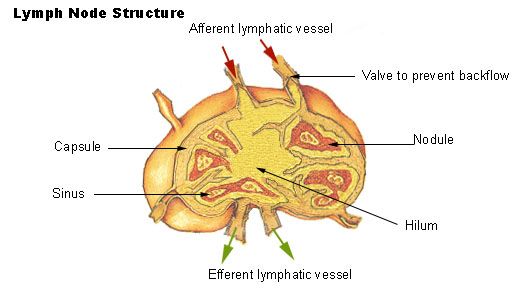Lymph Nodes
Lymph nodes are small bean-shaped structures that are usually less than 2.5 cm in length. They are widely distributed throughout the body along the lymphatic pathways where they filter the lymph before it is returned to the blood. Lymph nodes are not present in the central nervous system. There are three superficial regions on each side of the body where lymph nodes tend to cluster. These areas are the inguinal nodes in the groin, the axillary nodes in the armpit, and the cervical nodes in the neck.
The typical lymph node is surrounded by a connective tissue capsule and divided into compartments called lymph nodules. The lymph nodules are dense masses of lymphocytes and macrophages and are separated by spaces called lymph sinuses. Several afferent lymphatic vessels, which carry lymph into the node, enter the node on the convex side. The lymph moves through the lymph sinuses and enters an efferent lymphatic vessel, which carries the lymph away from the node. Because there are more afferent vessels than efferent vessels, the passage of lymph through the sinuses is slowed down, which allow time for the cleansing process. The efferent vessel leaves the node at an indented region called the hilum.

